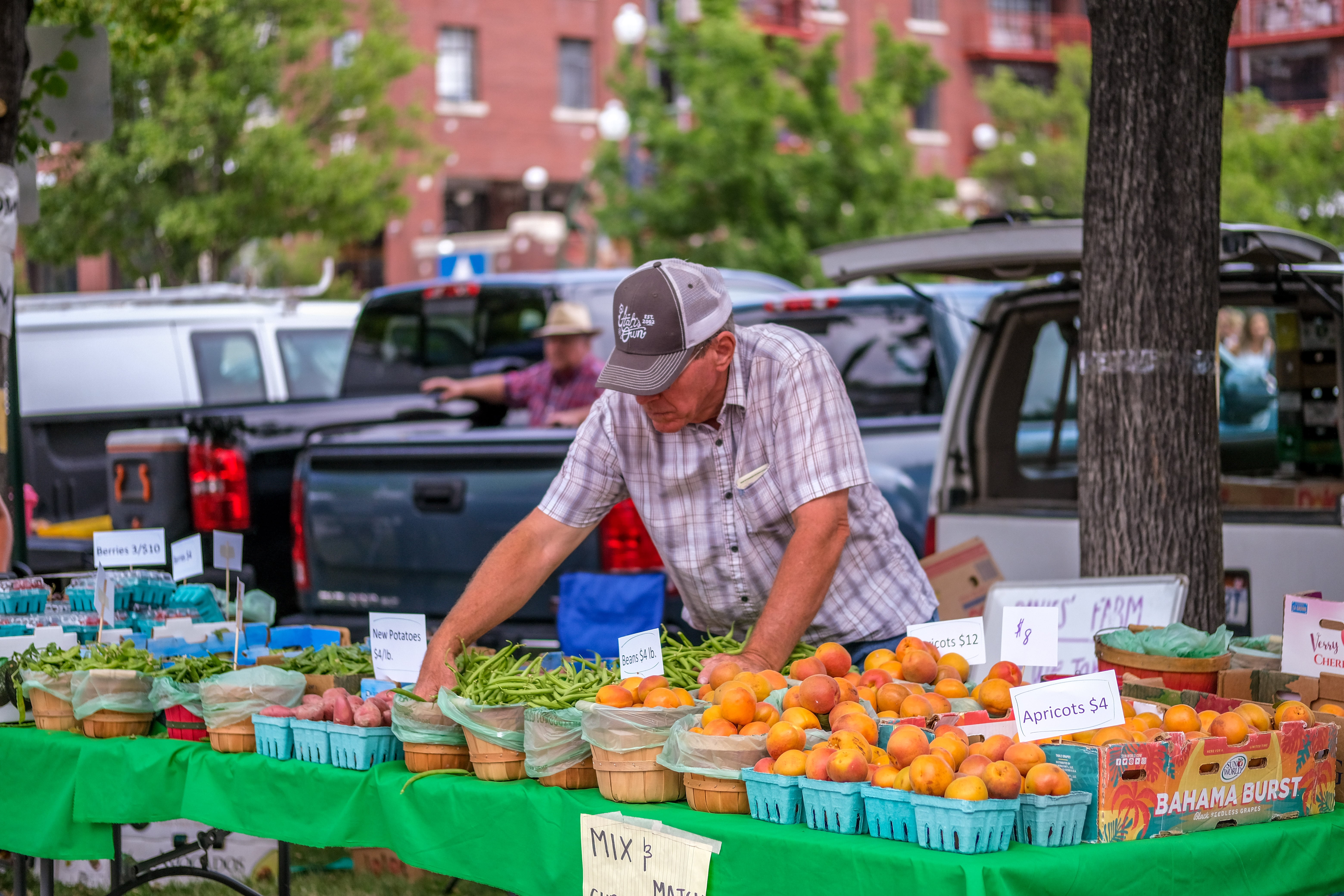By SLCgreen Intern Kate Kuwahara

Photo credit: Downtown SLC Farmers Market
The holiday season is upon us! This can be a time to gather with loved ones and enjoy some great food, often bringing recipes we only enjoy once or twice a year. Holidays can also be a great place to start when rethinking long-held traditions, habits, and how our actions can impact our community. Food waste is a major issue in the U.S. even outside of the holiday season. About 40% of all food produced in the U.S. never gets eaten, and this amount increases by an additional 25% between Thanksgiving and New Year’s!
However you celebrate, we encourage sustainable habits around gathering for the holidays, from food waste to decorations. And what better place to start than buying local food! Salt Lake City’s Winter Farmers’ Market returns on Saturdays beginning November 9th and will operate weekly from 10AM to 2PM through April 19th (closed November 30th and March 15th). SLCgreen’s summer intern Kate Kuwahara visited the Downtown Summer Farmers’ Market for the first time and shares her new perspective on farmer’s markets and learning more about our food systems.

Growing up, I have always had this preconceived notion that farmers’ markets were for the wealthy, or at least the upper middle class. A place for artisan vendors selling specialized items like caramelized cheese and aged balsamic vinegar. Or a source of entertainment for the latte-sipping shopper, perusing the truffle chip section on a Sunday morning with their designer dog on leash. In other words, not catered towards the average person and absolutely not a place to do your weekly grocery shopping.
This all changed when I visited the farmers’ market for the first time and saw that many items had prices comparable to those at the supermarket. I found that yes, there were certainly specialty items, but staple produce items like cucumbers, green beans, and corn were reasonably priced.
I was also struck by the variety of what I could find. Most grocery stores have one or two types of stone fruits. One stand I visited had six varieties, ranging from pluots to plumcots. I ended up getting many different items including fresh pasta, squash and even a hydroponically grown basil plant! This led me to re-evaluate my opinion of farmers’ markets and consider the question: what are the differences between the foods I get at the grocery store and what I could buy here?

As I did more research about how our food system is structured, I realized that although it produces and distributes food efficiently, it can take an unnecessary toll on the environment and our health.
What are some of the negative impacts of industrialized agriculture?
- Environmental Impacts: Industrial agriculture enables efficient and cost-effective food production but is not without its consequences. Specialization, like monocropping, depletes soil of its micronutrients and reduces biodiversity. Pesticide use has detrimental effects on animals and can contaminate water and soil.
Industrial agriculture is also a major contributor to global warming. There are a few different reasons for this. Industrial agriculture, like a lot of industries, is heavily reliant on fossil fuels, but there are less obvious ways that it heats up the planet as well. First of all, cows and other animal agriculture release an incredible amount of methane (even more than the oil and gas sector). Secondly, many farms are vastly over-fertilized which leads to the release of another greenhouse gas, nitrous oxide, into the atmosphere (they also create algal blooms, which is its own issue). And finally, when land is overgrazed or exploited for the sake of efficiency we lose a tremendous amount of carbon sequestration capacity. Forests and grasslands capture carbon incredibly well and we have redeveloped a lot of these ecosystems into farmland that doesn’t provide the same carbon capture.
- Human impacts: Industrial agriculture, particularly animal agriculture, can create health problems for people living in nearby communities due to the water and air pollution it creates. The agricultural sector is also rife with labor issues for farm workers, processers, and other supply chain workers. The work of farming is also poorly paid and can create health risks for farmworkers exposed to synthetic chemicals.
- Economic Impact: Apart from the various health and environmental effects, the industrial agriculture landscape caters to large companies and can price out small and medium-sized farms. In fact, just 3% of U.S. industrial farms generated 44% of production value as of 2019. This makes it very difficult for smaller farms to survive. Most small family farms have an operating profit margin of less than 10%.
How did we get here?
The history of the industrial agriculture movement can be traced back to the Great Depression and the severe drought of the 1930s. Circumstances such as agricultural overproduction post World War I coupled with economic turmoil led to the creation of the original Farm Bill, the Agriculture Adjustment Act. This was enacted to provide economic support to farmers and stabilize crop prices by providing subsidies for commodity crops such as corn, rice, wheat, soybeans and sugar.
Over time, the cheap prices of these commodities have incentivized their integration into many food products. They also provided a source of cheap feed for livestock, allowing for increases in consolidation of farms to maximize profit. This has resulted in extensive impacts on food quality, health and society, as discussed above.
Returning to localized food production
One way people are responding to the issues of industrial agriculture is to refocus on local foods, and an avenue for this is shopping at farmers markets. Not only do people get fresher food, but they can interact face to face with vendors and learn more about how and where their food is grown, a point of connection that gets lost in a typical grocery store.
Additionally, given the associations of processed foods with cardiometabolic diseases such as obesity and hypertension, farmers markets can be a source of healthy foods. Considering the disproportionate impact of the obesity epidemic on low-income families, it is important to increase access to fresh foods, something that farmers markets can help with.
What does accessibility to farmers’ markets look like in Salt Lake City?
Fresh produce can be expensive and one way the Salt Lake City Farmers’ Market works towards improving accessibility is by participating in the Double Up Food Bucks program. In this program the value of locally grown fruits and vegetables purchased with SNAP is matched. There is also the Seniors Farmers Market Nutrition Program, which offers $50 per year to qualified seniors to spend at various sites. Programs to incentivize fruit and vegetable consumption have also made their way into the healthcare setting. The Utah Produce Rx program allows for qualifying individuals to receive up to $300 to spend at farmers markets and local retailers.
These programs are a great way to incentivize shopping locally while helping with some of the cost differences. It also helps to quell arguments that farmers markets are elitist and only cater towards the wealthy. In fact, a study conducted by the Project for Public Spaces found that low-income shoppers used farmers markets more intensely than medium and high-income shoppers, highlighting the importance of the location of farmers markets and the expansion of vendors who accept food assistance program vouchers.

I hope this provides some more information about our current food system and how farmers’ markets fit into the equation. I, for one, am really excited to shop more at the farmers’ market and try new foods. I recently made a delicious dish with fresh pasta, zucchini, and basil, and can’t wait to think up some more meals! I encourage you to check out the next farmers market when you have a free Saturday. Happy eating!
